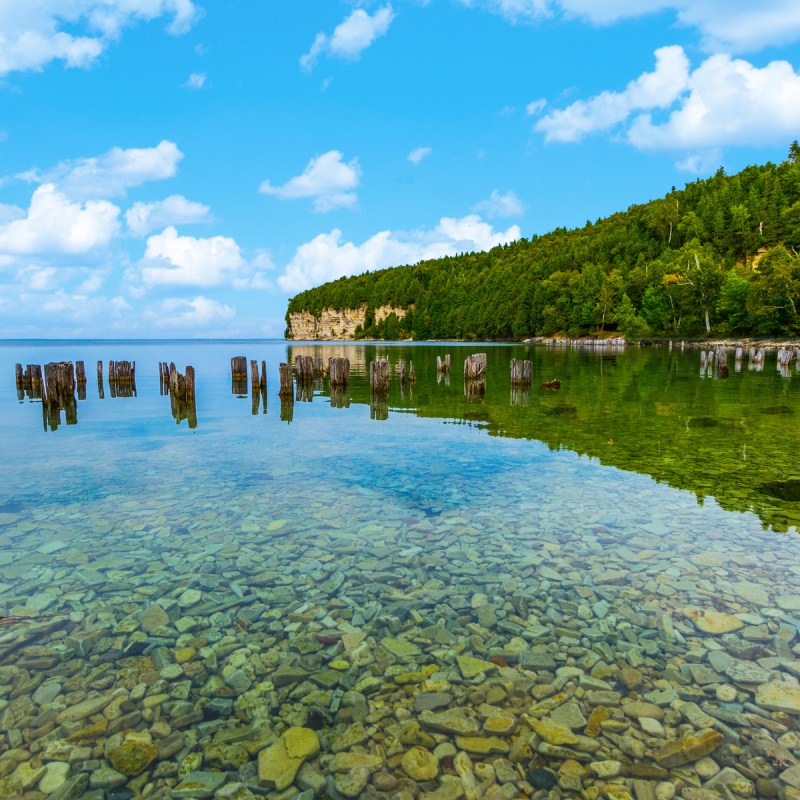
Summer or winter, Austria is always a desirable vacation destination. Whether you like to swim in a mountain lake, hike in flower-filled meadows, relax in thermal springs, or frolic in pristine snow, Austria will give you every opportunity to do it. The country will also enchant you with small, romantic towns and villages. You can admire rural, baroque churches, and the cozy wooden houses adorned with balconies laden with geraniums, painted walls, and elaborate wood carvings. Sleep in inns and dine on Austrian specialties, share tales and glasses of the famous Austrian wines with the locals who are willing to socialize with foreigners — even more so in the smaller towns.
Videos by TravelAwaits
We’ll introduce you to the most romantic small towns in Austria that will entice you to visit more than once.

1. Hallstatt
Hallstatt is a little town located in the Salzkammergut Mountains about a one-and-one-half hour drive from Salzburg on the shore of a crystalline lake of the same name. Salz, salt in English, is the main theme in this picturesque town that owes its wealth to the mining of salt in the nearby Salzwelten mine. Hallstatt is only accessible on foot, which adds to the romance of its 16th century bright red, pink, and yellow houses, steepled churches, and cobbled streets. All buildings are overflowing with ivy and geraniums which adds even more color. You can rent boats to see the exquisite panorama of Hallstatt from the water (no motorboats allowed) take the cable car to visit the ancient salt mine or just stroll around to look at the local shops. All shops sell pretty souvenirs, like wood carvings and little sachets of salt.

One of Hallstatt’s most interesting sights is the Charnel House. When burial space became sparse and graves had to be reused, the skulls of the deceased were exhumed, cleaned, and beautifully painted to be reburied in the “bone house,” located in the 12th-century St. Michael chapel. Skull painting is a local art form, used well into the 20th century.
Pro Tip: The best time to visit is October when there are far fewer tourists and the weather is still mild and sunny.

2. Alpbach
Alpbach is located on a sunny plateau in the Tyrol district of Kufstein. What distinguishes this lovely little village is the continuity in architecture. Local laws prohibit building any houses that do not adhere to the traditional wooden, timbered style. Gardens and flowers everywhere, as well as views of the majestic surrounding mountains, make Alpbach a romantic summer destination. But the village is popular in winter, too, because of good skiing and well-maintained slopes.
Alpbach is nicknamed the “Village of Thinkers,” because of the Alpbach European Forum, a think tank that has resulted in many innovations over the years. In the 15th century, copper and silver mining brought wealth to the community, much of it administered by the Fugger merchant family originally from Augsburg, Germany. Alpbach’s leading hotel, Boglerhof, dates is a step back in time with many original features still preserved. Tradition is foremost in Alpbach, and another nod to the past is a mountain farming museum.

3. Durnstein
The medieval town of Dürnstein is located on the Danube River in the Wachau Valley in Lower Austria and is just a 1-hour drive from Vienna. You can also travel here by boat on the river. You’ll be greeted by a stunning sight: a bright blue tower with white trimmings. Its baroque design dates from 1710 and is part of the monastery Stift Durnstein. High above the town sit the ruins of a castle, famous for once having been the prison of King Richard Lionheart.
The Wachau region of Austria is well-known for its wines and vineyards, especially Riesling and Green Veltliner. Plenty of opportunities for wine tastings await you just strolling through the medieval streets where time seems to stand still. Also try the local schnapps, an apricot liqueur. The German word is Marillenschnaps, so you know what to ask for.
Pro Tip: For a stunning view above the town and river, hike up to the castle, but make sure you choose the easier access route with many written indicators, as the more direct one is very steep and only for the super fit. In any event, good hiking shoes are a must.

4. Bad Gastein
Don’t get confused! The word “Bad” affixed to the name of a town doesn’t mean ugly or nasty but is the German word for a spa town with thermal springs and healing waters. Bad Gastein is located in a valley, surrounded by the mountain peaks of the Hohe Tauern, just south of Salzburg. The town became a fashionable spa resort in the 19th century because of its thermal springs, frequented by royalty, among them health fanatic Empress Elisabeth of Austria. You can spend a few relaxing hours in these healing waters in the Felsentherme. The town gained its sobriquet as the “Monte Carlo of the Alps,” because of the many Belle Époque hotels and houses that sit on the steep, forested, surrounding slopes and in the town center as well.
Bad Gastein is ideal for walking and hiking in the summer and skiing in the winter. You can even get sprayed at the roaring Gasteiner waterfall. If you are interested in the history of this spa, visit the Gasteiner Museum.

5. Zell am See
Located in a valley of the Kitzbuhel Alps near Salzburg, Zell lies on the shore of a lake of the same name. Surrounded by glaciers and high mountains, Zell’s attractions are hiking in the summer, skiing in the winter, or enjoying the views in the picturesque village while indulging in any imaginable watersport activity on the peanut-shaped lake. A truly romantic experience can be found in the Magic Lake Show. Every Tuesday, Thursday, and Sunday night a light show is staged, illuminating the lake in blue. Best of all, the spectacle is free.
The town is full of traditional cafes and restaurants, where you should try kaesespaetzle, a delicious calorie-laden dish of cheese noodles with gravy and onions. Who cares, you will do enough walking and hiking to burn it all off! Stop by the Romanesque St. Hippolyte church to gaze at the 118-foot-high tower. Zell’s Old Town is located on the western shore of the lake but you can go on a boat trip to see the rest.

6. St. Gilgen
St. Gilgen is located on the shore of one of Austria’s best-known and most idyllic lakes, the Wolfgangsee. Surrounded by the mountains of the Salzkammergut, the small village offers a great variety of summer activities. Foremost is a stroll along the lake or swimming or boating. In fact, the many boats that cross the lake, touching on St. Wolfgang, Ried, and other villages have made St. Gilgen popular in the first place. There are many hiking trails through the meadows while a quirky cog railway and Zwolferhorn cable car go up the mountain. The red cabins can be seen from everywhere in St. Gilgen, adding even more color to the pretty alpine wooden houses and their abundance of geraniums on balconies and in hanging baskets. The patron saint of St. Gilgen is Saint Aegidius and the parish church is dedicated to him. His statue greets you as you walk around town.

St.Gilgen has been dubbed as the “Mozart Village” by the tourist board although the great composer himself never visited. But, his grandfather worked here and his mother was born in St. Gilgen. Her paternal residence is now a museum open to visitors. You can even get married there.
Pro Tip: You must try the famous apfelstrudel with vanilla and cream. Sadly, Café Dallman is now permanently closed but there are many other cafes to taste this Austrian sweet treat. Another tip: the lakeshore is very steep, there is only a footpath connecting St. Gilgen with St.Wolfgang but the views are spectacular. Walk with care.

7. Millstatt
Millstatt is a market town and health resort, located on a peninsula on the northern shore of Lake Millstatt at the foot of the Gurktal Alps in southern Austria. The lake is the center of activity as well as relaxation. The southern shore is densely wooded and invites long walks to sample the fresh air. From 1870 on, Millstatt became a fashionable spa for the Austro-Hungarian Empire nobility. The remains of the 11th century Benedictine Abbey include a museum. Both are Millstatt landmarks.
Pro Tip: Find a local fisherman and try to persuade him to take you on a fishing trip across the lake to pull in his nets. A different kind of activity and an opportunity to meet the locals.
Many of Austria’s small towns and villages are located in alpine mountains and around dazzling lakes:
